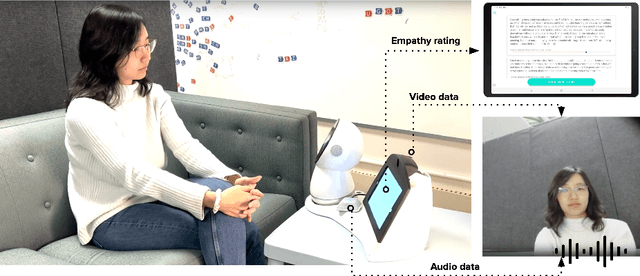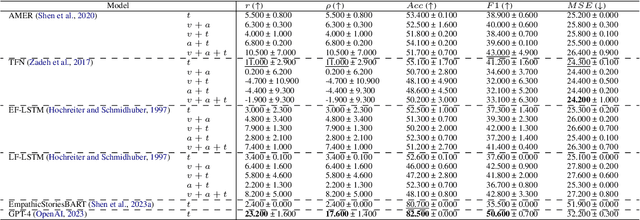Hae Won Park
Does "Reasoning" with Large Language Models Improve Recognizing, Generating, and Reframing Unhelpful Thoughts?
Mar 31, 2025Abstract:Cognitive Reframing, a core element of Cognitive Behavioral Therapy (CBT), helps individuals reinterpret negative experiences by finding positive meaning. Recent advances in Large Language Models (LLMs) have demonstrated improved performance through reasoning-based strategies. This inspires a promising direction of leveraging the reasoning capabilities of LLMs to improve CBT and mental reframing by simulating the process of critical thinking, potentially enabling more effective recognition, generation, and reframing of cognitive distortions. In this work, we investigate the role of various reasoning methods, including pre-trained reasoning LLMs and augmented reasoning strategies such as CoT and self-consistency in enhancing LLMs' ability to perform cognitive reframing tasks. We find that augmented reasoning methods, even when applied to "outdated" LLMs like GPT-3.5, consistently outperform state-of-the-art pretrained reasoning models on recognizing, generating and reframing unhelpful thoughts.
A Demonstration of Adaptive Collaboration of Large Language Models for Medical Decision-Making
Oct 31, 2024



Abstract:Medical Decision-Making (MDM) is a multi-faceted process that requires clinicians to assess complex multi-modal patient data patient, often collaboratively. Large Language Models (LLMs) promise to streamline this process by synthesizing vast medical knowledge and multi-modal health data. However, single-agent are often ill-suited for nuanced medical contexts requiring adaptable, collaborative problem-solving. Our MDAgents addresses this need by dynamically assigning collaboration structures to LLMs based on task complexity, mimicking real-world clinical collaboration and decision-making. This framework improves diagnostic accuracy and supports adaptive responses in complex, real-world medical scenarios, making it a valuable tool for clinicians in various healthcare settings, and at the same time, being more efficient in terms of computing cost than static multi-agent decision making methods.
HEART-felt Narratives: Tracing Empathy and Narrative Style in Personal Stories with LLMs
May 27, 2024Abstract:Empathy serves as a cornerstone in enabling prosocial behaviors, and can be evoked through sharing of personal experiences in stories. While empathy is influenced by narrative content, intuitively, people respond to the way a story is told as well, through narrative style. Yet the relationship between empathy and narrative style is not fully understood. In this work, we empirically examine and quantify this relationship between style and empathy using LLMs and large-scale crowdsourcing studies. We introduce a novel, theory-based taxonomy, HEART (Human Empathy and Narrative Taxonomy) that delineates elements of narrative style that can lead to empathy with the narrator of a story. We establish the performance of LLMs in extracting narrative elements from HEART, showing that prompting with our taxonomy leads to reasonable, human-level annotations beyond what prior lexicon-based methods can do. To show empirical use of our taxonomy, we collect a dataset of empathy judgments of stories via a large-scale crowdsourcing study with N=2,624 participants. We show that narrative elements extracted via LLMs, in particular, vividness of emotions and plot volume, can elucidate the pathways by which narrative style cultivates empathy towards personal stories. Our work suggests that such models can be used for narrative analyses that lead to human-centered social and behavioral insights.
EmpathicStories++: A Multimodal Dataset for Empathy towards Personal Experiences
May 24, 2024



Abstract:Modeling empathy is a complex endeavor that is rooted in interpersonal and experiential dimensions of human interaction, and remains an open problem within AI. Existing empathy datasets fall short in capturing the richness of empathy responses, often being confined to in-lab or acted scenarios, lacking longitudinal data, and missing self-reported labels. We introduce a new multimodal dataset for empathy during personal experience sharing: the EmpathicStories++ dataset (https://mitmedialab.github.io/empathic-stories-multimodal/) containing 53 hours of video, audio, and text data of 41 participants sharing vulnerable experiences and reading empathically resonant stories with an AI agent. EmpathicStories++ is the first longitudinal dataset on empathy, collected over a month-long deployment of social robots in participants' homes, as participants engage in natural, empathic storytelling interactions with AI agents. We then introduce a novel task of predicting individuals' empathy toward others' stories based on their personal experiences, evaluated in two contexts: participants' own personal shared story context and their reflections on stories they read. We benchmark this task using state-of-the-art models to pave the way for future improvements in contextualized and longitudinal empathy modeling. Our work provides a valuable resource for further research in developing empathetic AI systems and understanding the intricacies of human empathy within genuine, real-world settings.
Adaptive Collaboration Strategy for LLMs in Medical Decision Making
Apr 22, 2024Abstract:Foundation models have become invaluable in advancing the medical field. Despite their promise, the strategic deployment of LLMs for effective utility in complex medical tasks remains an open question. Our novel framework, Medical Decision-making Agents (MDAgents) aims to address this gap by automatically assigning the effective collaboration structure for LLMs. Assigned solo or group collaboration structure is tailored to the complexity of the medical task at hand, emulating real-world medical decision making processes. We evaluate our framework and baseline methods with state-of-the-art LLMs across a suite of challenging medical benchmarks: MedQA, MedMCQA, PubMedQA, DDXPlus, PMC-VQA, Path-VQA, and MedVidQA, achieving the best performance in 5 out of 7 benchmarks that require an understanding of multi-modal medical reasoning. Ablation studies reveal that MDAgents excels in adapting the number of collaborating agents to optimize efficiency and accuracy, showcasing its robustness in diverse scenarios. We also explore the dynamics of group consensus, offering insights into how collaborative agents could behave in complex clinical team dynamics. Our code can be found at https://github.com/mitmedialab/MDAgents.
Improving Dialogue Agents by Decomposing One Global Explicit Annotation with Local Implicit Multimodal Feedback
Mar 17, 2024Abstract:We describe an approach for aligning an LLM-based dialogue agent based on global (i.e., dialogue-level) rewards, while also taking into account naturally-occurring multimodal signals. At a high level, our approach (dubbed GELI) learns a local, turn-level reward model by decomposing the human-provided Global Explicit (GE) session-level reward, using Local Implicit (LI} multimodal reward signals to crossmodally shape the reward decomposition step. This decomposed reward model is then used as part of the standard RHLF pipeline improve an LLM-based dialog agent. We run quantitative and qualitative human studies to evaluate the performance of our GELI approach, and find that it shows consistent improvements across various conversational metrics compared to baseline methods.
Health-LLM: Large Language Models for Health Prediction via Wearable Sensor Data
Jan 12, 2024



Abstract:Large language models (LLMs) are capable of many natural language tasks, yet they are far from perfect. In health applications, grounding and interpreting domain-specific and non-linguistic data is important. This paper investigates the capacity of LLMs to deliver multi-modal health predictions based on contextual information (e.g. user demographics, health knowledge) and physiological data (e.g. resting heart rate, sleep minutes). We present a comprehensive evaluation of eight state-of-the-art LLMs with diverse prompting and fine-tuning techniques on six public health datasets (PM-Data, LifeSnaps, GLOBEM, AW_FB, MIT-BIH & MIMIC-III). Our experiments cover thirteen consumer health prediction tasks in mental health, activity, metabolic, sleep, and cardiac assessment. Our fine-tuned model, Health-Alpaca exhibits comparable performance to larger models (GPT-3.5 and GPT-4), achieving the best performance in 5 out of 13 tasks. Ablation studies highlight the effectiveness of context enhancement strategies, and generalization capability of the fine-tuned models across training datasets and the size of training samples. Notably, we observe that our context enhancement can yield up to 23.8% improvement in performance. While constructing contextually rich prompts (combining user context, health knowledge and temporal information) exhibits synergistic improvement, the inclusion of health knowledge context in prompts significantly enhances overall performance.
Integrating Flow Theory and Adaptive Robot Roles: A Conceptual Model of Dynamic Robot Role Adaptation for the Enhanced Flow Experience in Long-term Multi-person Human-Robot Interactions
Jan 05, 2024Abstract:In this paper, we introduce a novel conceptual model for a robot's behavioral adaptation in its long-term interaction with humans, integrating dynamic robot role adaptation with principles of flow experience from psychology. This conceptualization introduces a hierarchical interaction objective grounded in the flow experience, serving as the overarching adaptation goal for the robot. This objective intertwines both cognitive and affective sub-objectives and incorporates individual and group-level human factors. The dynamic role adaptation approach is a cornerstone of our model, highlighting the robot's ability to fluidly adapt its support roles - from leader to follower - with the aim of maintaining equilibrium between activity challenge and user skill, thereby fostering the user's optimal flow experiences. Moreover, this work delves into a comprehensive exploration of the limitations and potential applications of our proposed conceptualization. Our model places a particular emphasis on the multi-person HRI paradigm, a dimension of HRI that is both under-explored and challenging. In doing so, we aspire to extend the applicability and relevance of our conceptualization within the HRI field, contributing to the future development of adaptive social robots capable of sustaining long-term interactions with humans.
Modeling Empathic Similarity in Personal Narratives
May 23, 2023Abstract:The most meaningful connections between people are often fostered through expression of shared vulnerability and emotional experiences in personal narratives. We introduce a new task of identifying similarity in personal stories based on empathic resonance, i.e., the extent to which two people empathize with each others' experiences, as opposed to raw semantic or lexical similarity, as has predominantly been studied in NLP. Using insights from social psychology, we craft a framework that operationalizes empathic similarity in terms of three key features of stories: main events, emotional trajectories, and overall morals or takeaways. We create EmpathicStories, a dataset of 1,500 personal stories annotated with our empathic similarity features, and 2,000 pairs of stories annotated with empathic similarity scores. Using our dataset, we fine-tune a model to compute empathic similarity of story pairs, and show that this outperforms semantic similarity models on automated correlation and retrieval metrics. Through a user study with 150 participants, we also assess the effect our model has on retrieving stories that users empathize with, compared to naive semantic similarity-based retrieval, and find that participants empathized significantly more with stories retrieved by our model. Our work has strong implications for the use of empathy-aware models to foster human connection and empathy between people.
HIINT: Historical, Intra- and Inter- personal Dynamics Modeling with Cross-person Memory Transformer
May 21, 2023Abstract:Accurately modeling affect dynamics, which refers to the changes and fluctuations in emotions and affective displays during human conversations, is crucial for understanding human interactions. By analyzing affect dynamics, we can gain insights into how people communicate, respond to different situations, and form relationships. However, modeling affect dynamics is challenging due to contextual factors, such as the complex and nuanced nature of interpersonal relationships, the situation, and other factors that influence affective displays. To address this challenge, we propose a Cross-person Memory Transformer (CPM-T) framework which is able to explicitly model affective dynamics (intrapersonal and interpersonal influences) by identifying verbal and non-verbal cues, and with a large language model to utilize the pre-trained knowledge and perform verbal reasoning. The CPM-T framework maintains memory modules to store and update the contexts within the conversation window, enabling the model to capture dependencies between earlier and later parts of a conversation. Additionally, our framework employs cross-modal attention to effectively align information from multi-modalities and leverage cross-person attention to align behaviors in multi-party interactions. We evaluate the effectiveness and generalizability of our approach on three publicly available datasets for joint engagement, rapport, and human beliefs prediction tasks. Remarkably, the CPM-T framework outperforms baseline models in average F1-scores by up to 7.3%, 9.3%, and 2.0% respectively. Finally, we demonstrate the importance of each component in the framework via ablation studies with respect to multimodal temporal behavior.
 Add to Chrome
Add to Chrome Add to Firefox
Add to Firefox Add to Edge
Add to Edge